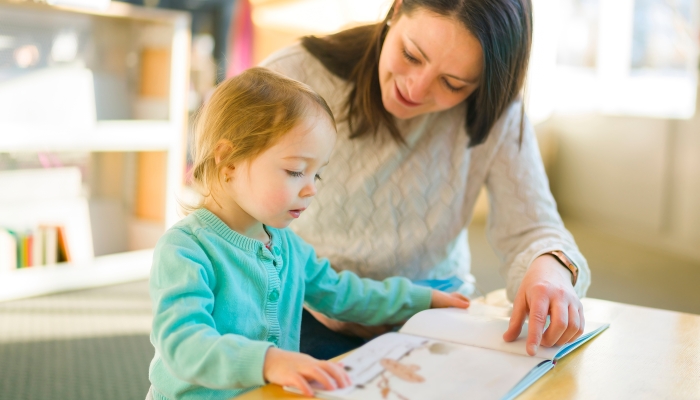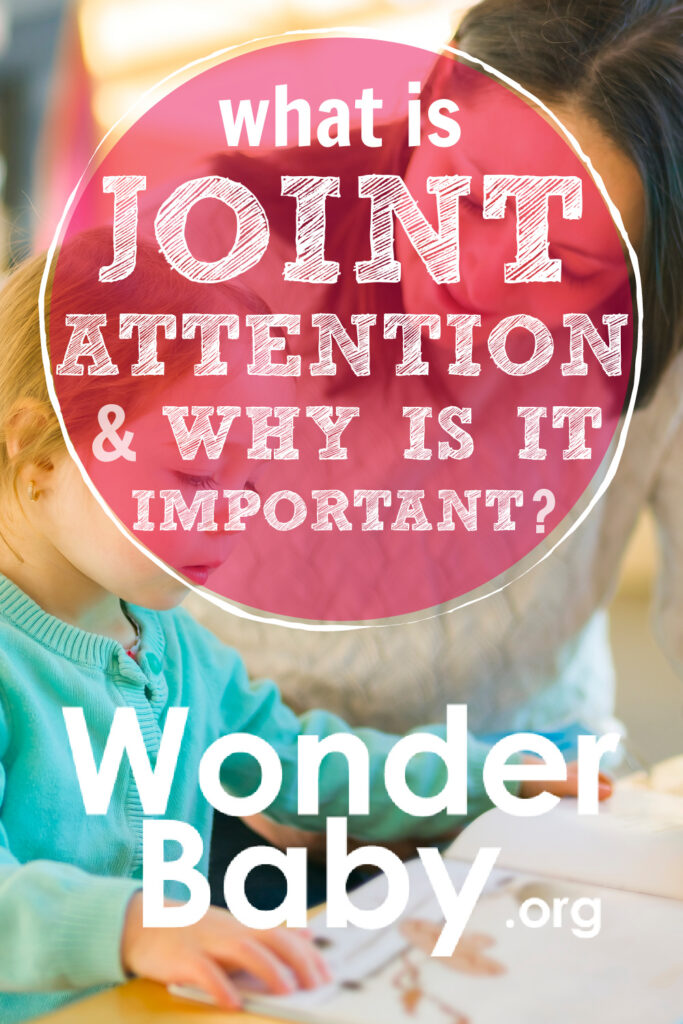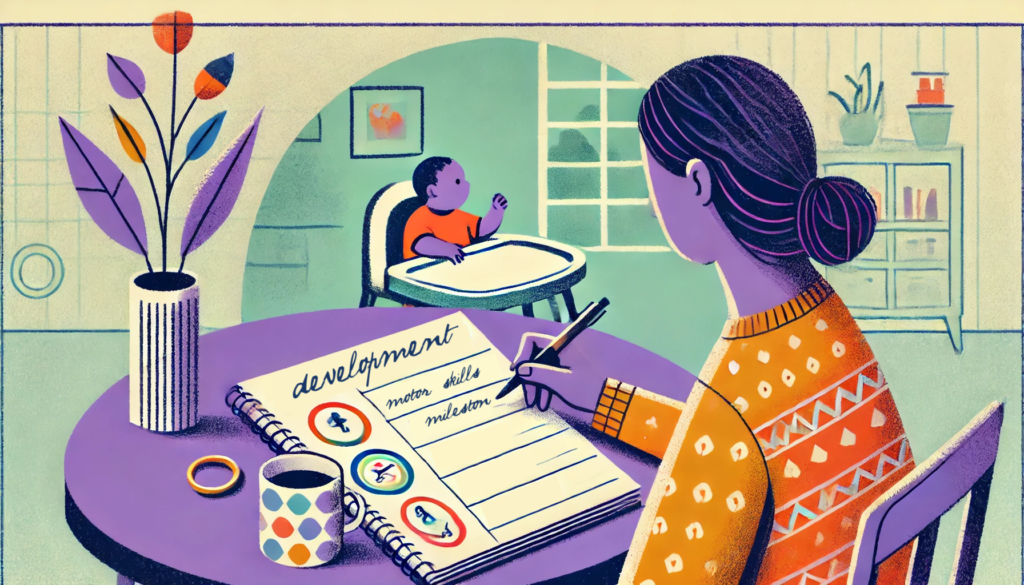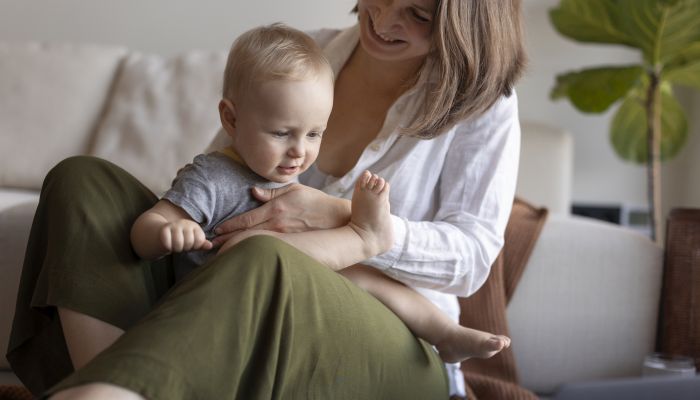What Is Joint Attention & Why Is It Important?

- Joint attention is the intentional act of two people sharing a common focus on an object or event.
- The ability to engage with another person about a shared interest or object is necessary for developing relationships.
- Children begin responding to joint attention around 6 months of age.
- Parents can learn games and strategies to foster shared attention.
- If your child struggles with joint attention skills, professional support can help build these skills.
You focus on your baby’s face, looking at each feature. You sing to them and smile. And then one day, they smile back.
As your baby grows, your interaction grows. Eventually, your baby follows your gaze to engage in a toy or a book. Then suddenly, your toddler is pointing and engaging with you. This early social interaction is the beginning of joint attention.
Joint attention is the intentional act of two people sharing a common focus on an object or event. Shared attention is necessary for developing relationships and social learning skills.
For some children, focusing on an object and an individual simultaneously can be difficult. Learning strategies to help your child enhance joint attention skills and knowing when to seek professional help will help your child’s social and communication skills.
What Is Joint Attention?
For communication to be successful, two people must interact with each other regarding a shared object or event. This shared attention, called joint attention, is an early form of social communicative behavior.
The world is new to your child. When learning a new skill or interacting with a new toy, sharing the experience with another makes it more exciting. A parent might point to a toy and the child responds by pointing, laughing, or making eye contact with the parent to establish joint attention.
A child might initiate joint attention or respond to joint attention. It is easier for a child to respond to joint attention than to initiate it.
Responding To Joint Attention
Responding to joint attention occurs when a parent points or looks in a particular direction and the child follows the gesture or eye gaze. In typically developing children, this behavior begins around 6 months of age.
A parent might say “look at that ball” while pointing towards the ball. If the child engages with the parent by looking at them and then follows through with looking at the ball, the child is responding to joint attention.
Initiating Joint Attention
Initiating joint attention typically starts to develop around 9 months of age. At this stage, a child will initiate social interaction by pointing or gazing at an item in an attempt to get the other person to look. Initiating joint attention is harder, and the ability to do this varies significantly with typically developing children

Why Does Joint Attention Matter?
Joint attention plays an important part in your child’s social communication skills, social development, and cognitive development. The ability to engage with another person regarding a shared interest or object is necessary for developing relationships.
Joint attention helps with bonding and nurturing relationships. It increases your child’s social skills and allows your child to see another’s point of view and engage in a more meaningful way.
A child’s joint attention skills can also encourage early language development. According to the 2014 study Joint Attention and Vocabulary Development: A Critical Look, by Nameera Akhtar, PhD, and Morton Ann Gernsbacher, PhD, learning language can occur without joint attention skills but a child’s ability to engage in joint focus can increase language learning.
Difficulties with joint attention might also be an indicator of a global developmental delay or an early marker for autism spectrum disorder (ASD). If a child’s joint attention is limited, practice strategies that promote joint attention or speak with a professional for more support. Early intervention, or reaching out when your child is young, can result in the best outcomes for your child.
When Should a Child Exhibit Joint Attention?
For many children, joint attention skills develop soon after birth. The ability to respond to joint attention begins around 6 months of age. This skill typically evolves through 9 months of age when some children start initiating joint attention. By three years old, most children are usually competent at gaining and maintaining joint attention in social interactions.
Joint attention skills may be affected by physical or developmental disorders such as deafness, blindness, or autism spectrum disorders.
Early skills of joint attention include:
- Following the parent’s eye gaze or point to see what the parent is looking at.
- Looking at the same page of a book with parent.
- Reaching out when wanting to be picked up.
- Pointing to something they want out of reach.
- Engaging in reciprocal conversation.
- Ability to shift attention between an object and person.
Later developed skills of joint attention include:
- The ability to focus on a game with another player.
- Requesting items.
- The ability to engage another person’s attention to an object.
- Gaze checking or looking to see if another person is looking at the same thing.
How To Tell If a Child Has Joint Attention Issues
Joint attention involves paying attention to a person and an object. This mutual focus is a deliberate act of engagement. Your child might struggle with joint attention if he has difficulty interacting with you and paying attention to an object simultaneously.
Signs of joint attention issues include:
- The parent or adult has to work hard to get the child’s attention.
- The child tunes out verbal directions, potentially their own name at times.
- A child over 12 months doesn’t try to initiate attention from another person.
- When something is wrong, the child doesn’t try to gain attention from another to show what is wrong.
- The child prefers to play alone and do their own thing and seems uninterested or unable to engage with others.

Strategies To Promote Joint Attention In Children
There are several interactive strategies you can do with your child at an early age to help develop joint attention. Start by selecting simple activities that capture your infant’s attention. As your child grows select activities appropriate for your child’s development and skills.
When implementing these skills, focus on your facial expressions. Be engaging and use an animated voice to capture your child’s attention.
Use a Sing-Song Voice
Practice establishing joint attention with your infant and small child using a sing-song voice. Choose simple toys your infant focuses on the most to engage interest. Practice looking at the chosen object and then at your baby.
Your infant typically will engage for only brief moments. During this time smile and offer encouraging words: “Do you see the bear? I see you looking at him!” Look back and forth from the object to your child.
Practice Redirecting Attention
As your child’s ability to focus on an object increases, practice redirecting their attention to something else. When focused on a toy, talk with them and gain their attention, and then offer a different toy to engage with.
Create Opportunities for Surprise
Blow bubbles together and take turns popping them. When your child pops a bubble, gasp and see if they turn to look at you. Try different fine motor activities to play together. Roll a car back and forth or build a tall tower. If the cars collide or the tower collapses, react and see if your child focuses their attention on you and then back to the toys.
Play hide and seek with your child’s favorite toy. When your child asks where the toy is, point to where it is hidden saying “there it is!” Play this game over and over until your child consistently follows your point. Advance the game to only gazing in the direction of the toy to challenge your child and see if they can follow your eye gaze.
Focus on Faces And Eye Contact
Make a point to focus on your infant and child’s face. Encourage maintaining eye contact with each other. Follow your child’s lead. If your child seems uncomfortable with establishing eye contact, walk away for a while.
It is common for children with autism spectrum disorders to be uncomfortable making eye contact with others. If your child is diagnosed with ASD, consult with their therapist regarding maintaining eye contact with your child.
Incorporate Joint Attention into Daily Routines
Think about your daily routine and look for ways to incorporate joint engagement during mealtimes, bathtime, and when brushing teeth.
Play Games
Play games together to practice turn taking. Allow your child to move objects on the game board and then verbally interact with them to gain attention. Do activities that involve back in forth engagement like board games and puzzles.
Dance Together
Turn on the music and grab your child’s hands. Dance together to the music. This allows your child to practice joint attention by engaging with you while dancing and listening to music.
When To See a Professional For Your Child’s Joint Attention Issues
Early intervention and support can help your child focus on building joint attention skills. Children with autism, developmental delays, or other social cognition concerns benefit from professional support.
If you are concerned for your child’s development, speak with a developmental pediatrician to help create the best plan for your child. Treatment may include a referral to a speech-language pathologist, occupational therapist or applied behavior analysis (ABA) therapist. ABA therapists focus on building social skills to develop joint attention.

Related Posts

Development, Special Needs
How to Track Milestones for Developmentally Delayed Babies
Parents of developmentally delayed babies can explore practical tools and strategies to track milestones, celebrate progress, and support their child’s unique developmental journey.

Fine and Gross Motor
5 Alternatives to Tummy Time for Babies with Motor Development Challenges
Does your baby struggle with tummy time due to motor development challenges? These alternatives to tummy time will offer the same benefits.

Development
Should Twins Share a Room?
Wondering if your twins should share a room? We’ll explore the pros and cons of room-sharing for twins right here before you make your decision.